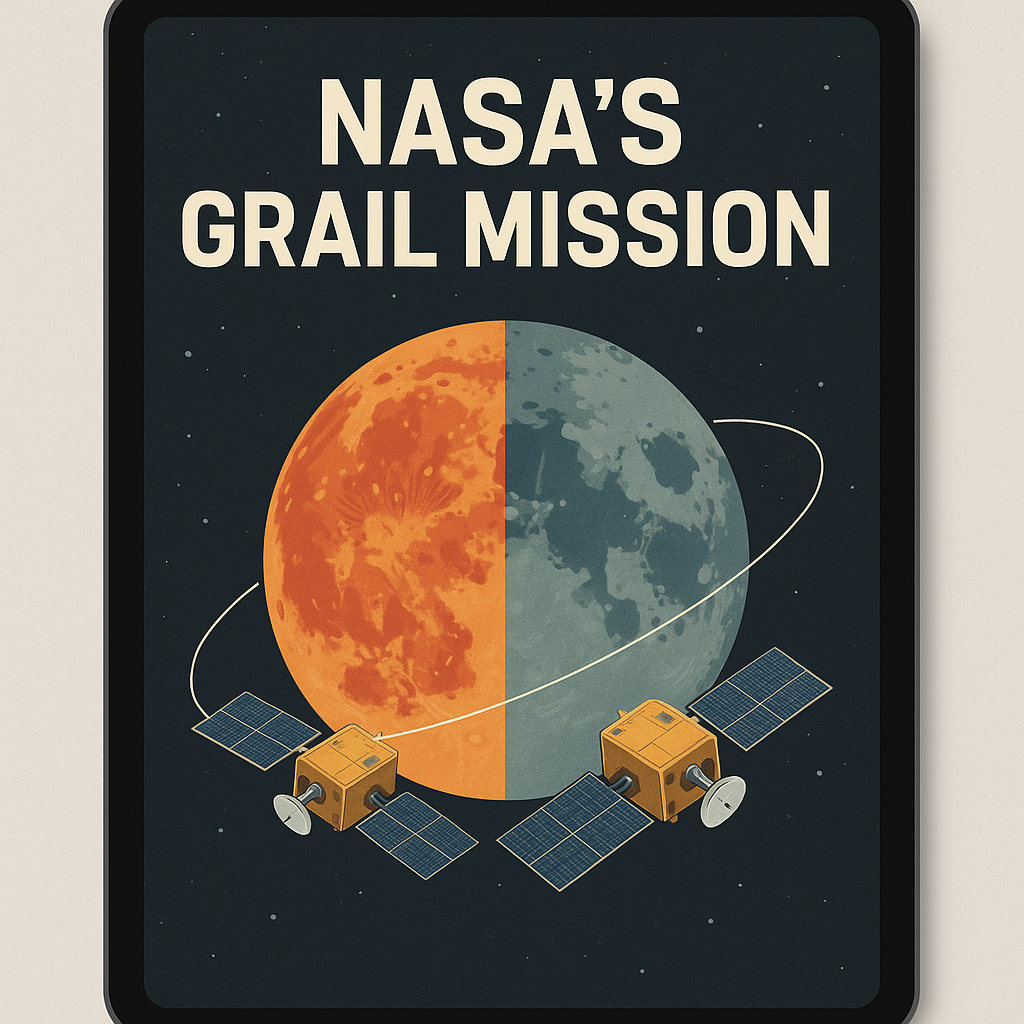
May 19, 2025, Post 1: 🌕Hidden Depths: NASA’s GRAIL Mission Maps the Moon’s Interior Asymmetry | High Quality Mains Essay | Prelims MCQs
🌕 Post Date ;May 19, 2025
Hidden Depths: NASA’s GRAIL Mission Maps the Moon’s Interior Asymmetry
SCIENCE & TECHNOLOGY

🎯 Thematic Focus:
Planetary Science | Moon Research | Space Technology | Gravitational Mapping
🕊️ Opening Whisper
The Moon always shows us the same face — but its hidden side now tells a new story.
🔍 Key Highlights:
- NASA’s GRAIL Mission (Gravity Recovery And Interior Laboratory) has revealed that the Moon’s nearside and farside differ significantly in internal structure and geological activity.
- The nearside, facing Earth, has a warmer, softer mantle with more radioactive, heat-generating elements like thorium and titanium.
- The farside has a cooler, more rigid mantle, explaining the contrast between the flat lava plains (mare) on the nearside and rugged highlands on the farside.
- GRAIL data confirms tidal deformation — the Moon flexes more on the nearside due to Earth’s gravity, supporting thermal asymmetry.
- The mission delivered the most detailed gravity map of the Moon ever, aiding future lunar exploration.
🚀 GRAIL Mission Overview:
- Agency: NASA
- Launch Date: September 10, 2011
- Orbit Start: December 31, 2011
- End of Mission: December 17, 2012 (controlled lunar impact)
- Spacecraft: Two identical satellites – Ebb and Flow
- Objective: Create a high-resolution gravitational map of the Moon to understand its interior structure, thermal history, and volcanic evolution.
🌐 Global and Scientific Significance:
- The mission’s findings help decode the Moon’s geological evolution, shedding light on why it looks so different on each side.
- GRAIL technology can be applied to other moons like Enceladus (Saturn) and Ganymede (Jupiter), boosting astrobiology and the search for extraterrestrial life.
- Gravity maps from GRAIL enhance precision landings, rover navigation, and subsurface resource detection — key for future Moon bases.
- Reinforces the Moon’s essential role in stabilizing Earth’s rotation and driving tides, critical for maintaining planetary life.
📘 GS Paper Mapping:
- GS Paper 3: Science & Technology – Developments in Space Technology
- GS Paper 1: Geography – Earth and Celestial Bodies
- Essay/Interview: Moon Missions | Space Exploration and Global Cooperation
✨ A Thought Spark — by IAS Monk
We stare at the Moon for stories. But now, with gravity as our guide, we read its soul — and discover that even familiar companions carry secrets deeper than craters.
High Quality Mains Essay For Practice :
Word Limit 1000-1200
GRAIL and the Lunar Divide: How Gravity Unveiled the Moon’s Inner Asymmetry
Introduction
The Moon, Earth’s constant companion and celestial mirror, has long fascinated humanity. While it always presents the same face to Earth, its hidden hemisphere remained a mystery until space probes began to map it in detail. NASA’s GRAIL (Gravity Recovery and Interior Laboratory) mission has now provided a new dimension to lunar exploration — not through images, but through gravity. By measuring minute variations in the Moon’s gravitational field, GRAIL has uncovered striking internal asymmetries between the Moon’s nearside and farside, offering profound insights into its geological past, its volcanic activity, and its role in Earth’s evolution.
What is the GRAIL Mission?
The GRAIL mission, launched by NASA in September 2011, involved two identical spacecraft — Ebb and Flow — that orbited the Moon in tandem. Their objective was simple yet revolutionary: to map the Moon’s gravitational field with unprecedented precision. By tracking subtle changes in the distance between the two spacecraft as they passed over different lunar regions, scientists could infer variations in mass density, thereby creating a detailed gravitational map of the Moon’s interior.
This technique — similar to what was earlier used on Earth by the GRACE satellites — allowed GRAIL to “see” beneath the surface of the Moon without digging or drilling.
Major Discoveries: A Tale of Two Moons
1. Interior Asymmetry
GRAIL revealed that the nearside, which always faces Earth, has a softer, warmer, and more geologically active mantle. It contains higher concentrations of radioactive, heat-producing elements such as thorium and potassium. This internal heat likely contributed to the extensive volcanic activity on this side during the Moon’s early history.
In contrast, the farside has a colder, stiffer mantle, with rugged highlands and very little volcanic resurfacing. This explains why the nearside is covered in lava plains (mare) while the farside is pockmarked with ancient craters and highlands.
2. Tidal Deformation
Another key finding is the difference in tidal flexing between the two hemispheres. The Moon is subject to Earth’s gravitational pull, and its nearside — being closer — experiences greater tidal deformation. This means it flexes more, implying a hotter and more pliable interior on that side. This also supports the theory that Earth’s gravity played a role in shaping the Moon’s internal structure.
3. Thermal History and Volcanism
The GRAIL mission supports the theory that volcanic eruptions on the nearside were fed by internal heating, enhanced by radioactive decay and tidal stress. These eruptions released not just lava but heat-producing elements, which became concentrated on the surface, creating a feedback loop that made the nearside even more geologically active.
Scientific and Strategic Importance
- The gravitational map produced by GRAIL is the most detailed ever for any celestial body. It will be critical for future Moon missions involving landings, rover deployments, and subsurface exploration.
- The mission has wider planetary implications. Similar gravity-mapping techniques can be used to study icy moons like Europa, Ganymede, or Enceladus, which may harbor subsurface oceans — and possibly extraterrestrial life.
- Understanding the Moon’s structure also enhances our knowledge of Earth-Moon dynamics, including how the Moon stabilizes Earth’s axial tilt and influences ocean tides, both crucial for sustaining life on Earth.
The Broader Implications for Humanity
The GRAIL mission reinforces the idea that space exploration is not just about distant discovery, but deep understanding. By mapping gravity, we unlock geological history, interior composition, and evolutionary pathways — not only of the Moon but of other worlds.
Moreover, such insights help us prepare for the return of humans to the Moon, especially under programs like NASA’s Artemis. Precision gravity data ensures safe landings, resource prospecting, and possibly the construction of permanent lunar habitats.
Conclusion
The Moon has long been a canvas for poetry, mythology, and exploration. With GRAIL, it now becomes a blueprint of internal mysteries — where every wrinkle in gravity tells a story of fire, pressure, and time. NASA’s achievement is not merely a feat of engineering, but a testament to humanity’s quest to read the invisible and to find patterns in the pull of distant rocks.
In understanding the Moon’s uneven interior, we also glimpse the subtle balances that have made Earth a cradle of life. GRAIL has gifted us gravity not as a force — but as a lens to look within.
Target IAS-26: Daily MCQs :
📌 Prelims Practice MCQs
Topic:
MCQ 1 – Type 1: How many of the following statements are correct?
Consider the following statements regarding NASA’s GRAIL Mission:
1. GRAIL consisted of two identical satellites named Echo and Reflex.
2. The nearside of the Moon has a warmer, more geologically active mantle compared to the farside.
3. The GRAIL mission ended with a controlled crash into the Moon’s surface.
4. GRAIL data helped develop the most detailed gravitational map of the Earth.
How many of the above statements are correct?
A) Only two
B) Only three
C) All four
D) Only one
🌀 Didn’t get it? Click here (▸) for the Correct Answer & Explanation
✅ Correct Answer: B) Only three
🧠 Explanation:
B) Only three
•1) ❌ False – The satellites were named Ebb and Flow, not Echo and Reflex.
•2) ✅ True – The Moon’s nearside is warmer and more geologically active.
•3) ✅ True – The mission ended with a controlled crash in 2012.
•4) ✅ True – GRAIL developed the most detailed gravitational map of the Moon, not Earth.
MCQ 2 – Type 2: Two-Statement Check
Consider the following two statements:
1. The nearside of the Moon formed vast mare plains due to ancient intense volcanism.
2. The farside of the Moon has a thicker, denser crust with fewer heat-generating elements.
Which of the above statements is/are correct?
A) Only 1 is correct
B) Only 2 is correct
C) Both are correct
D) Neither is correct
🌀 Didn’t get it? Click here (▸) for the Correct Answer & Explanation
✅ Correct Answer: C) Both are correct
🧠 Explanation:
Correct Answer: C) Both are correct
•1) ✅ True – Volcanism on the nearside led to mare plains formation.
•2) ✅ True – The farside has a thicker, less active crust with fewer heat-generating elements.
MCQ 3 –Type 3: Which of the following statements is/are correct?
Consider the following statements about the significance of NASA’s GRAIL mission:
1. It supports future lunar missions by providing high-resolution gravitational mapping.
2. It confirmed the presence of microbial life on the Moon.
3. It helps understand tidal deformation due to Earth’s gravitational influence.
Select the correct answer using the code given below:
A) 1 and 2 only
B) 1 and 3 only
C) 2 and 3 only
D) 1, 2 and 3
🌀 Didn’t get it? Click here (▸) for the Correct Answer & Explanation
✅ Correct Answer: B) 1 and 3 only
🧠 Explanation:
Correct Answer: B) 1 and 3 only
•1) ✅ True – GRAIL data supports future navigation and landings.
•2) ❌ False – There’s no evidence of life on the Moon.
•3) ✅ True – It helped analyze tidal deformation caused by Earth.
MCQ 4 – Type 4: Direct Fact-Based
Which of the following best describes the names of the spacecraft used in NASA’s GRAIL mission?
A) Apollo and Artemis
B) Ebb and Flow
C) Voyager 1 and 2
D) Dawn and Dusk
🌀 Didn’t get it? Click here (▸) for the Correct Answer & Explanation.
✅ Correct Answer: B) Ebb and Flow
🧠 Explanation:
Correct Answer: B) Ebb and Flow
• The two spacecraft were named Ebb and Flow to reflect their function of tracking lunar gravitational changes caused by the tidal flexing of the Moon.


















